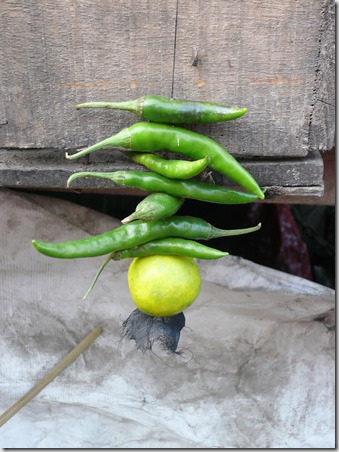For your new vehicle, the Indian traditions dictate the ceremonial “nimbu-mirchi totka” comprising of one lemon and seven green chillies, strung together to form a hanging piece which is supposed to ward off evil.
No new vehicle is moved without hanging this totka on to it. Though most of us believe and religiously follow these numbers(7 chillies, 1 lemon), most of us overlook few important set of numbers which manufacturers of these vehicles provide. These are the matrix of numbers which give the kilometres run and the corresponding maximum speed to be followed by your vehicle in different gears. The process which is completed once these numbers are adhered to is called as “running in” or “break in” of the machinery.
The numbers are something like these:
(for representation only. Refer your owners manual)
| For first 500 kms | 501 – 2000 kms | |
|
Gear |
Speed |
Speed |
|
15 kmph | 20 kmph |
|
25 kmph | 30 kmph |
|
30 kmph | 40 kmph |
|
45 kmph | 55 kmph |
|
60 kmph | 70 kmph |
What is the running in and why is it so important?
To answer this, first lets get to the bottom of manufacturing process. Most of the parts like pistons, rings, gears, shafts etc. in a vehicle are manufactured using either one or combination of turning on lathe, milling, cutting etc. These manufacturing processes, though they have achieved a very high precision after the advent of CNC machines, still are not good enough to prevent formation of burrs or create a perfectly dimensioned part.
So what is a burr?
Burr is a small extension of metal which is created while working on a metal by processes like cutting, threading, milling etc. Though CNC machines and high precision tools limit the amount of burrs to micro levels, be sure that they are present.
Apart from this, these parts, or for that matter most of the other parts manufactures by such processes, cannot be made perfect to their dimensions, significantly due to the shortcomings of the machineries which manufacture them. Thus, a piston ring may not have the perfect edge contour, which matches with the inner walls of the cylinder liner after it is fitted.
When your vehicle runs for the first few 100 kms, these meshing parts rub against each other and the friction results in heat generation. If the speed of the vehicle is increased above permissible limit for corresponding gear, there is all the likelihood that the amount of heat generated goes out of proportion and enough to damage the component permanently. Eg. If the engine is loaded above the permissible limit during run-in period, the piston rings scratch the cylinder liner irreversibly. These scratched surface will keep on causing further damage to piston ring in future, thus shortening the life of both the cylinder liner and the piston rings.
Secondly, during the run-in period, the parts which mesh together, wear off and give off small metal filings which get deposited and carried away by the engine oil. The micro burrs too wear off at this stage and leaves behind a smooth component. These micro burrs too get carried away with the oil.
In case the machinery is run at higher load/speed, these filings in the oil have the potential to damage the bearings and other sliding/rotating components. At lower speed/loads, this possibility is reduced.
I’ve run in the bike and it was bit boring. Now what?
Remember that small booklet that the vehicle manufacturer supplied with the vehicle? The user manual? Just check in it. Normally, you should be due for your first free check up at this time, as specified by the service coupon. If you see carefully, the job card for the first free service(normally on the reverse of the service coupon) specifies replacement of engine oil and engine filter. This is a very important step. The engine oil is drained, sump is cleaned(sump is the lowest portion of the engine where oil is held for circulation), oil filter is cleaned and new oil is filled up in the engine at this point. Unless this is done, the engine will be fed with the metal fillings via the oil for a long time, thus leading to a gradually increasing wear of the engine components and the oil pump. So be sure that your service centre personnel carry out this step. Once this is done, it is always safe to follow the running in routine speeds for few thousand kilometres(1000 to 2000 kms) to ensure proper performance in long run.
Tips
-
Insist on driving the vehicle from show room to your home/registration centre yourself. Showroom people normally don’t care much about other peoples vehicle once the sale is through. I’ve seen many brand new a bikes/cars being driven ultra-rashly by showroom delivery boys. My heart goes out to the engines and transmission components of those vehicles and to the owners of those vehicles.
-
If you hear complaints about the shoddy work by service centre, insist on staying with the bike till the servicing is done(Absurd but effective)
-
Note down the kms in presence of the service centre personnel. That way every km run can be accounted for.
-
Before and after service, check the oil color using dip stick. The oil after service will be visibly lighter in color as compared to pre-service.
-
Do not try to do the first service(or any other free service) yourself at home. You will void the warranty.
-
Keep the oil topped up to recommended level with the recommended oil.
Once you finish your break-in or running in of the vehicle machinery, you can be assured of a very long component life and trouble free engine. Happy driving/riding.

